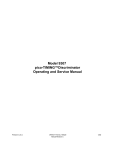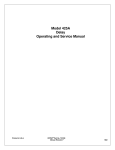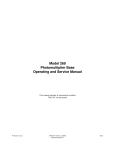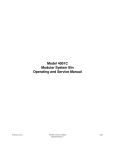Download Model 9326 Fast Preamplifier Operating and Service Manual
Transcript
Model 9326
Fast Preamplifier
Operating and Service Manual
Printed in U.S.A.
ORTEC® Part No. 777620
Manual Revision C
1202
Advanced Measurement Technology, Inc.
a/k/a/ ORTEC®, a subsidiary of AMETEK®, Inc.
WARRANTY
ORTEC* warrants that the items will be delivered free from defects in material or workmanship. ORTEC makes
no other warranties, express or implied, and specifically NO WARRANTY OF MERCHANTABILITY OR
FITNESS FOR A PARTICULAR PURPOSE.
ORTEC’s exclusive liability is limited to repairing or replacing at ORTEC’s option, items found by ORTEC to
be defective in workmanship or materials within one year from the date of delivery. ORTEC’s liability on any
claim of any kind, including negligence, loss, or damages arising out of, connected with, or from the performance
or breach thereof, or from the manufacture, sale, delivery, resale, repair, or use of any item or services covered
by this agreement or purchase order, shall in no case exceed the price allocable to the item or service furnished
or any part thereof that gives rise to the claim. In the event ORTEC fails to manufacture or deliver items called
for in this agreement or purchase order, ORTEC’s exclusive liability and buyer’s exclusive remedy shall be release
of the buyer from the obligation to pay the purchase price. In no event shall ORTEC be liable for special or
consequential damages.
Quality Control
Before being approved for shipment, each ORTEC instrument must pass a stringent set of quality control tests
designed to expose any flaws in materials or workmanship. Permanent records of these tests are maintained for
use in warranty repair and as a source of statistical information for design improvements.
Repair Service
If it becomes necessary to return this instrument for repair, it is essential that Customer Services be contacted in
advance of its return so that a Return Authorization Number can be assigned to the unit. Also, ORTEC must be
informed, either in writing, by telephone [(865) 482-4411] or by facsimile transmission [(865) 483-2133], of the
nature of the fault of the instrument being returned and of the model, serial, and revision ("Rev" on rear panel)
numbers. Failure to do so may cause unnecessary delays in getting the unit repaired. The ORTEC standard
procedure requires that instruments returned for repair pass the same quality control tests that are used for
new-production instruments. Instruments that are returned should be packed so that they will withstand normal
transit handling and must be shipped PREPAID via Air Parcel Post or United Parcel Service to the designated
ORTEC repair center. The address label and the package should include the Return Authorization Number
assigned. Instruments being returned that are damaged in transit due to inadequate packing will be repaired at the
sender's expense, and it will be the sender's responsibility to make claim with the shipper. Instruments not in
warranty should follow the same procedure and ORTEC will provide a quotation.
Damage in Transit
Shipments should be examined immediately upon receipt for evidence of external or concealed damage. The carrier
making delivery should be notified immediately of any such damage, since the carrier is normally liable for damage
in shipment. Packing materials, waybills, and other such documentation should be preserved in order to establish
claims. After such notification to the carrier, please notify ORTEC of the circumstances so that assistance can be
provided in making damage claims and in providing replacement equipment, if necessary.
Copyright © 2002, Advanced Measurement Technology, Inc. All rights reserved.
*ORTEC® is a registered trademark of Advanced Measurement Technology, Inc. All other trademarks used
herein are the property of their respective owners.
iii
CONTENTS
WARRANTY . . . . . . . . . . . . . . . . . . . . . . . . . . . . . . . . . . . . . . . . . . . . . . . . . . . . . . . . . . . . . . . . . . . . . . . ii
SAFETY INSTRUCTIONS AND SYMBOLS . . . . . . . . . . . . . . . . . . . . . . . . . . . . . . . . . . . . . . . . . . . . . . . iv
SAFETY WARNINGS AND CLEANING INSTRUCTIONS . . . . . . . . . . . . . . . . . . . . . . . . . . . . . . . . . . . . . v
1. DESCRIPTION . . . . . . . . . . . . . . . . . . . . . . . . . . . . . . . . . . . . . . . . . . . . . . . . . . . . . . . . . . . . . . . . . . . 1
2. SPECIFICATIONS . . . . . . . . . . . . . . . . . . . . . . . . . . . . . . . . . . . . . . . . . . . . . . . . . . . . . . . . . . . . . . . .
2.1. PERFORMANCE . . . . . . . . . . . . . . . . . . . . . . . . . . . . . . . . . . . . . . . . . . . . . . . . . . . . . . . . . . . . .
2.2. CONTROLS . . . . . . . . . . . . . . . . . . . . . . . . . . . . . . . . . . . . . . . . . . . . . . . . . . . . . . . . . . . . . . . . .
2.3. INPUTS . . . . . . . . . . . . . . . . . . . . . . . . . . . . . . . . . . . . . . . . . . . . . . . . . . . . . . . . . . . . . . . . . . . .
2.4. OUTPUTS . . . . . . . . . . . . . . . . . . . . . . . . . . . . . . . . . . . . . . . . . . . . . . . . . . . . . . . . . . . . . . . . . .
2.5. ELECTRICAL AND MECHANICAL . . . . . . . . . . . . . . . . . . . . . . . . . . . . . . . . . . . . . . . . . . . . . . . .
1
1
1
1
1
1
3. INSTALLATION AND STARTUP . . . . . . . . . . . . . . . . . . . . . . . . . . . . . . . . . . . . . . . . . . . . . . . . . . . . .
3.1. SETUP . . . . . . . . . . . . . . . . . . . . . . . . . . . . . . . . . . . . . . . . . . . . . . . . . . . . . . . . . . . . . . . . . . . . .
3.1.1. Preamplifier Input . . . . . . . . . . . . . . . . . . . . . . . . . . . . . . . . . . . . . . . . . . . . . . . . . . . . . . .
3.1.1.1. Setting the Coarse Gain . . . . . . . . . . . . . . . . . . . . . . . . . . . . . . . . . . . . . .
3.1.2. Cable Connections . . . . . . . . . . . . . . . . . . . . . . . . . . . . . . . . . . . . . . . . . . . . . . . . . . . . . .
3.1.3. Preamplifier Output . . . . . . . . . . . . . . . . . . . . . . . . . . . . . . . . . . . . . . . . . . . . . . . . . . . . . .
3.1.4. Preamplifier Power . . . . . . . . . . . . . . . . . . . . . . . . . . . . . . . . . . . . . . . . . . . . . . . . . . . . . .
2
2
2
2
4
4
4
4. MAINTENANCE . . . . . . . . . . . . . . . . . . . . . . . . . . . . . . . . . . . . . . . . . . . . . . . . . . . . . . . . . . . . . . . . . . 4
iv
SAFETY INSTRUCTIONS AND SYMBOLS
This manual contains up to three levels of safety instructions that must be observed in order to avoid
personal injury and/or damage to equipment or other property. These are:
DANGER
Indicates a hazard that could result in death or serious bodily harm if the safety instruction is
not observed.
WARNING
Indicates a hazard that could result in bodily harm if the safety instruction is not observed.
CAUTION
Indicates a hazard that could result in property damage if the safety instruction is not
observed.
Please read all safety instructions carefully and make sure you understand them fully before attempting to
use this product.
In addition, the following symbol may appear on the product:
ATTENTION – Refer to Manual
DANGER – High Voltage
Please read all safety instructions carefully and make sure you understand them fully before attempting to
use this product.
v
SAFETY WARNINGS AND CLEANING INSTRUCTIONS
DANGER
Opening the cover of this instrument is likely to expose dangerous voltages. Disconnect the
instrument from all voltage sources while it is being opened.
WARNING Using this instrument in a manner not specified by the manufacturer may impair the
protection provided by the instrument.
Cleaning Instructions
To clean the instrument exterior:
! Unplug the instrument from the ac power supply.
! Remove loose dust on the outside of the instrument with a lint-free cloth.
! Remove remaining dirt with a lint-free cloth dampened in a general-purpose detergent and water
solution. Do not use abrasive cleaners.
CAUTION To prevent moisture inside of the instrument during external cleaning, use only enough liquid
to dampen the cloth or applicator.
!
Allow the instrument to dry completely before reconnecting it to the power source.
vi
1
ORTEC MODEL 9326
FAST PREAMPLIFIER
1. DESCRIPTION
The Model 9326 Fast Preamplifier is optimized for
amplifying the pulses from microchannel plate
detectors, electron multipliers, photomultiplier
tubes, fast photodiodes, and silicon charged-particle
detectors. The fast rise times of these detectors are
preserved by the <1-ns rise time of the Model 9326
output, which can supply 0- to -1-V pulse
amplitudes into a 50- load. The compact size
permits placement close to the detector to avoid
ground loop and environmental noise interference
with the small signals produced by the detector.
Gains of 5, 10, or 20 volts/volt (non-inverting) can
be selected via a board jumper.
S
A low-frequency roll-off less than 10 kHz is unusual
for a preamplifier intended for processing fast
detector pulses. This low-frequency response was
incorporated to virtually eliminate pulse undershoot
when used with the FASTFLIGHTTM Digital Signal
Averager in the electrospray time-of-flight mass
spectrometry application.
To minimize damage caused by large transients
from the detector, the input incorporates overload
protection. The output is also short-circuit protected.
Any 9-pin-D preamplifier power connector meeting
the ORTEC standard pin assignments can be used
to supply the +12!V power via a standard power
cable.
2. SPECIFICATIONS
2.1. PERFORMANCE
2.4. OUTPUTS
:
INPUT NOISE <100 V rms.
OUTPUT RISE TIME
ANALOG OUTPUT Rear-panel BNC connector
provides a negative-polarity output pulse. Linear
range is nominally +0.25 V to -1 V on a 50- load.
AC-coupled and short-circuit protected.
<1 ns.
S
LOW FREQUENCY ROLL-OFF <10 kHz.
GAIN Selectable by board jumpers for 5, 10, or
20 V/V. The overall gain is non-inverting.
OPERABLE TEMPERATURE RANGE 0–50°C.
2.2. CONTROLS
COARSE GAIN Board jumper selection of low
(5 V/V), medium (10 V/V), or high (20 V/V) gain.
2.3. INPUTS
ANALOG INPUT
Front-panel BNC connector
accepts negative-polarity analog signals in the
range of 0 to -200 mV. Input impedance: 50 ac,
dc to ground. Diode clamps provide
<1000
protection against overload to ±2 V dc, or ±10 V for
a 50-ns wide pulse at a duty cycle <1%.
S
S
2.5. ELECTRICAL AND MECHANICAL
POWER Requires +12 V at 100 mA dc power,
which is supplied through a 3-m (9.8-ft) power cord
included with the Model 9326. The mating
connectors on the ends of the power cord are
ORTEC-standard, 9-pin-D, preamplifier power
connectors. Pin assignments for the male connector
on the preamplifier case are +12 V on pin 4, and
ground on pins 1 and 2.
WEIGHT
(2.9 lb).
Net 0.39 kg (0.85 lb); shipping 1.3 kg
DIMENSIONS Compact preamplifier box: 8.6 cm
W × 13.3 cm D × 3.0 cm H (3.4 in. W × 5.3 in. D ×
1.2 in. H).
2
3. INSTALLATION AND STARTUP
NOTE
The correct coaxial cable
impedance is critical for the
connections between the detector
and the Model 9326 Fast
Preamplifier input, and between
the preamplifier output and the
load. Only RG-58A/U cable can be
used to match the 50termination impedances at the
input to the preamplifer and the
load. Cables not having a 50characteristic impedance, as does
RG-58/U (53.5- ), will cause
reflections of the input pulses at
the ends of the cable. Always use
high-quality RG-58A/U 50coaxial cable.
S
S
S
S
3.1. SETUP
CAUTION To avoid damaging the
preamplifier, disconnect it from all
voltage sources before removing
the cover.
CAUTION Set the Model 9326 coarse-gain
jumper before connecting the unit
to any other equipment.
CAUTION The Model 9326 should not be
subjected to temperatures in
excess of 50°C.
3.1.1. Preamplifier Input
3.1.1.1. Setting the Coarse Gain
The Model 9326 Preamplifier Input has three
coarse-gain settings (5 V/V, 10 V/V, and 20 V/V).
To change the gain:
1. Remove the two outboard screws on the rear
panel of the preamplifier. Do not remove the
screw between the Output and Power
connectors.
2. Slide the printed wiring board (PWB) out of the
case by pulling on the rear panel output
connector.
3. Figure 1 shows the location of the gain jumper
on the board. (Note that the values of the three
jumper settings are printed on the board beside
their respective settings.) Change the board
jumper to the desired gain setting.
4. Carefully slide the board back into the same
suspension slots on the preamplifier case.
5. Insert the two outboard screws to reattach the
rear panel to the case.
3
4
3.1.2. Cable Connections
Connect the output of the detector to the INPUT of
the Model 9326 with 50- , RG-58A/U coaxial cable
having matching BNC connectors. It is best to keep
the cable length short (<30 cm) to provide a lowresistance ground path between the detector and
preamplifier grounds. This will minimize the
interference from ground-loop noise. If the detector
has dc high voltage on its output, a high-voltage
isolation capacitor will need to be installed in series
with the detector output to prevent damage to the
preamplifier input. To avoid damaging the
preamplifier input, always turn off the detector high
voltage and ensure that the voltage on the center
pin of the detector connector is zero before
connecting to the preamplifier input.
S
If a connector adapter is required, keep the cable
between the detector and preamplifier as short as
possible to minimize the effects of cable reflections.
To avoid ground-loop noise, it may be desirable to
isolate the detector ground from its mechanical
mount with a modest resistance (100–1000 ). This
ensures that the preamplifier will establish the
ground reference for the detector signal, eliminating
a ground loop.
S
3.1.3. Preamplifier Output
Connect the preamplifier OUTPUT to the load using
50- , RG-58A/U coaxial cable with matching BNC
connectors. The length of this cable is not critical,
but it should not be longer than necessary.
S
3.1.4. Preamplifier Power
The cable supplied for connecting preamplifier
power has a female, 9-pin D connector on one end
and a male, 9-pin D connector on the other.
Connect the female end to the POWER connector
on the rear of the Model 9326. Connect the male
end to any standard ORTEC PREAMP POWER
connector.
4. MAINTENANCE
The Model 9326 requires very little maintenance other than routine removal of dust and tightening of mechanical
connections.

















